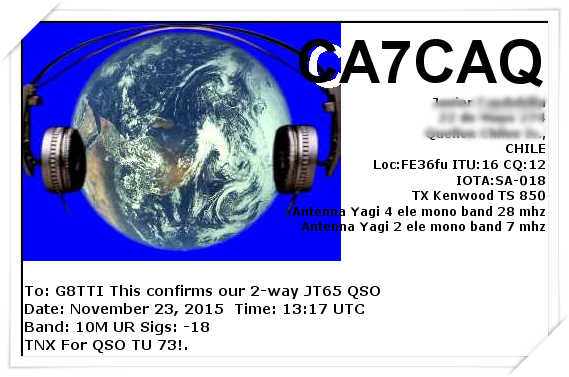Inspiration
It's the ultimate challenge of amateur radio, Earth-Moon-Earth also known as moon bounce but is it possible with a small station like mine? Until recently I would have said no but after using MAP65 from K1JT I'm starting to think that maybe it is possible.I've been using SDRs for some time now on VHF, so I already had available the IQ output needed to use MAP65. This allows the decoding of all JT65B signals within a 90kHz bandwidth. I've used the software to monitor beacons on Two with good success, at times being able to decode four beacons at the same time, GB3WGI, GB3NGI, GB3VHF and F5ZRB. But it never occurred to me to try and hear anything off the Moon. That was until one evening while watching an art programme an item appeared about artist Katie Patterson's Earth- Moon - Earth.
Katie used EME to record Beethoven's Moonlight sonata complete with gaps due to fading and then replayed it on a modern player piano. This romantic idea of radio waves going to the Moon and back was an inspiration so I started reading all about EME. I soon discovered that with JT65B, on Two, small stations were having success with single yagis and no elevation.
Help needed
 | |||
| Ground gain or in this case sea gain |
First monitoring
So with this in mind, I started to monitor off the Moon. Pointing my small 9 element beam towards Moonrise I left MAP65 running overnight. Moonrise would occur in the early hours so I wouldn't know if anything had been received until the following morning. Come morning there was just one line in the band map, "73", time, signal strength, etc. So to see if anything else had been received I opened up the text file Map65-rx found inside the MAP65 folder. It contained all decoded data received through the night and to my amazement several stations had been received, two Russians and an Italian. Pretty encouraging but I had in the past, while monitoring beacons, seen false decodes so to be sure I turned off the Deep Search and renamed the CALL_3 file to be sure that I was indeed hearing off the Moon.
Once again I pointed the beam towards Moonrise, left MAP65 running and waited to see what might be decoded with the Deep Search disabled. Once again there were several stations decoded and this time they could not be false decodes.
More monitoring
Over the following weeks, I continued to monitor and I soon started to realize that signals could be heard from Moon elevations of just 1 degree to as high as 25. Outside this range decodes are few and far between but they did occur even 1 degree below the horizon on one occasion and at 60 degrees above.
Next.......
I've improved receive performance by building a new preamp. I'm looking very carefully at the transmitted signal as getting audio harmonics to a low level seems important to me. I need to familiarize myself with the operation of WSJT JT65B. Just monitoring is easy but TXing is going to be more demanding. I need to test my amp at the high duty cycle of JT65B........etc...etc....... but hopefully I'll soon be ready for that first contact. I'll post here if I make it.Cheers & beers
Dave G8TTI
UPDATE
15/12/2016
Well, I keep trying but not had much luck so far. Was spotted on Livecq by a Dutch station but can't help wonder if that was tropo. Also had a QRZ, well I think it was for me. I'll just have to keep trying. Amp works fine and I have a 12dBd antenna to try, hopefully, that will help.
73


































